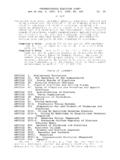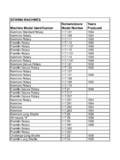Transcription of Seven themes of sustainable forest management Productive ...
1 Cover photos: Seven themes of sustainable forest management Left, top to bottom: forest biological diversity ( Wilkie); forest health and vitality (FAO/FO-0506/C. Palmberg Lerche);. Productive functions of forest resources (FAO/FO-6960/J. Carle). Centre: Extent of forest resources ( Wilkie). Right, top to bottom: Protective functions of forest resources ( Wilkie); Socio-economic functions of forests (FAO/FO-5154/Veracel); Legal, policy and institutional framework (FAO/24683_1206/G. Napolitano). Global forest Resources FAO. FORESTRY. PAPER. Assessment 2010 163. Main report FOOD AND AGRICULTURE ORGANIZATION OF THE UNITED NATIONS. Rome, 2010. 1DA @AOECJ=PEKJO AILHKUA@ =J@ PDA LNAOAJP=PEKJ KB I=PANE=H EJ PDEO. EJBKNI=PEKJ LNK@Q?P @K JKP EILHU PDA ATLNAOOEKJ KB =JU KLEJEKJ SD=POKARAN. KJ PDA L=NP KB PDA #KK@ =J@ CNE?QHPQNA ,NC=JEV=PEKJ KB PDA 2 JEPA@ +=PEKJO. # , ?KJ?ANJEJC PDA HAC=H KN @ARAHKLIAJP OP=PQO KB =JU ?KQJPNU PANNEPKNU ?EPU. KN =NA= KN KB EPO =QPDKNEPEAO KN ?
2 KJ?ANJEJC PDA @AHEIEP=PEKJ KB EPO BNKJPEANO KN. >KQJ@=NEAO 1DA IAJPEKJ KB OLA?EBE? ?KIL=JEAO KN LNK@Q?PO KB I=JQB=?PQNANO SDAPDAN KN JKP PDAOA D=RA >AAJ L=PAJPA@ @KAO JKP EILHU PD=P PDAOA D=RA. >AAJ AJ@KNOA@ KN NA?KIIAJ@A@ >U # , EJ LNABANAJ?A PK KPDANO KB = OEIEH=N. J=PQNA PD=P =NA JKP IAJPEKJA@ . &0 + . HH NECDPO NAOANRA@ # , AJ?KQN=CAO NALNK@Q?PEKJ =J@ @EOOAIEJ=PEKJ KB. I=PANE=H EJ PDEO EJBKNI=PEKJ LNK@Q?P +KJ ?KIIAN?E=H QOAO SEHH >A BNAA KB ?D=NCA QLKJ NAMQAOP /ALNK@Q?PEKJ BKN NAO=HA KN KPDAN ?KIIAN?E=H. LQNLKOAO EJ?HQ@EJC A@Q?=PEKJ=H LQNLKOAO I=U EJ?QN BAAO LLHE?=PEKJO BKN. LANIEOOEKJ PK NALNK@Q?A KN @EOOAIEJ=PA # , ?KLUNECDP I=PANE=HO =J@ =HH. MQANEAO ?KJ?ANJEJC NECDPO =J@ HE?AJ?AO ODKQH@ >A =@@NAOOA@ >U A I=EH PK. ?KLUNECDP B=K KNC KN PK PDA DEAB -Q>HEODEJC -KHE?U =J@ 0 QLLKNP N=J?D ,BBE?A KB (JKSHA@CA "T?D=JCA /AOA=N?D =J@ "TPAJOEKJ # , 3E=HA @AHHA 1 ANIA @E =N=?=HH= /KIA &P=HU . # , . iii Contents Acknowledgements x Foreword xi Acronyms and abbreviations xii Executive summary xiii Chapter 1.)
3 Introduction 1. The reporting framework 2. The scope of FRA 2010 3. The process 5. The outputs 8. Chapter 2. Extent of forest resources 9. Overview 9. Key findings 10. Key conclusions 11. forest area and forest area change 11. forest characteristics 23. Selected forest types and species groups 27. Growing stock 35. Biomass 41. Carbon stock 44. Chapter 3. forest biological diversity 49. Overview 49. Key findings 50. Key conclusions 51. Area of primary forests 52. forest area designated for conservation of biological diversity 56. Area of forest in protected areas 59. Tree species composition 62. Chapter 4. forest health and vitality 65. Overview 65. Key findings 66. Key conclusions 67. Insects and diseases 67. forest fires 74. Other disturbances 80. Chapter 5. Productive functions of forest resources 85. Overview 85. Key findings 85. Key conclusions 86. Areas designated for Productive functions 87. Planted forests 90. iv Afforestation and reforestation 95.
4 Removals of wood products 100. Removals of non-wood forest products 103. Chapter 6. Protective functions of forest resources 109. Overview 109. Key findings 109. Key conclusions 109. forest area designated for protective purposes 110. Chapter 7. Socio-economic functions of forest resources 119. Overview 119. Key findings 119. Key conclusions 121. Ownership and management rights 121. Public expenditure and revenue collection 127. Value of wood and non-wood forest product removals 136. Employment 143. Area of forest designated for social services 146. Chapter 8. Legal, policy and institutional framework 149. Overview 149. Key findings 149. Key conclusions 150. Policy and legal framework 150. Institutional framework 154. Education and research 158. Chapter 9. Progress towards sustainable forest management 163. Introduction 163. Status of forest management 163. Progress towards sustainable forest management 168. Chapter 10. Conclusions 187. Scope and coverage of FRA 2010 187.
5 The FRA 2010 process 189. Progress towards sustainable forest management 191. Next steps 193. Bibliography 195. Annexes 199. Annex 1: Contributors 199. Annex 2: Terms and definitions used in FRA 2010 209. Annex 3: Global tables 217. Annex 4: FRA 2010 working papers 327. Annex 5: FRA 2010 meetings and workshops 331. Annex 6: Earlier global assessments 333. v Tables FRA 2010 reporting tables and links to the thematic elements of sustainable forest management 4. Key statistics for regions and subregions used in FRA 2010 6. Distribution of forests by region and subregion, 2010 13. High forest cover countries, 2010 14. forest cover by region and subregion, 2010 15. Annual change in forest area by region and subregion, 1990 2010 18. Ten countries with largest annual net loss of forest area, 1990 2010 21. Ten countries with largest annual net gain in forest area, 1990 2010 21. Comparison of forest area estimates in FRA 2010 and FRA 2005 22. Trends in area of mangroves by region and subregion, 1990 2010 30.
6 Trends in area of bamboo by country and region, 1990 2010 31. Trends in area of rubber plantations by country and region, 1990 2010 33. Growing stock by region and subregion, 2010 35. Growing stock of commercial species by region and subregion, 2010 37. Trends in growing stock in forest by region and subregion, 1990 2010 38. Trends in growing stock composition by region and subregion, 1990 2010 39. Trends in growing stock of commercial species by region and subregion, 1990 2010 40. Trends in growing stock in other wooded land by region and subregion, 1990 2010 40. Biomass and dead wood stock by region and subregion, 2010 42. Biomass conversion and expansion factor, root shoot ratio and dead live ratio by region and subregion, 2010 42. Trends in total biomass in forests by region and subregion, 1990 2010 43. Trends in dead wood stocks by region and subregion, 1990 2010 44. Carbon stock in forest by region and subregion, 2010 45. Trends in carbon stocks in forest biomass by region and subregion, 1990 2010 46.
7 Trends in carbon stocks in dead wood and litter combined, by region and subregion, 1990 2010 47. Trends in carbon stocks in forest soil by region and subregion, 1990-2010 48. Trends in total carbon stocks in forests, 1990 2010 48. Area of primary forest by region and subregion, 2010 53. Ten countries with the highest percentage of primary forest , 2010 54. Trends in area of primary forest by region and subregion, 1990 2010 55. Area of forest designated for conservation of biodiversity by region and subregion, 2010 57. Trends in area of forest designated for conservation of biodiversity by region and subregion, 1990 2010 58. Area of forest in protected areas by region and subregion, 2010 60. Trends in area of forest in protected areas by region and subregion, 1990 2010 61. Growing stock of the ten most common species as a percentage of total growing stock by region and subregion, 2005 63. Average area of forest annually affected by insects by region and subregion, 2005 70.
8 Vi Average area of forest annually affected by diseases by region and subregion, 2005 70. Trends in area of forest annually affected by insects by region and subregion, 1990 2005 73. Trends in area of forest annually affected by diseases by region, 1990 2005 73. Ten most prevalent insect pests reported 74. Most prevalent pathogens reported 74. Average area of forest annually affected by fire by region and subregion, 2005 75. Trends in area of forest annually affected by fire by region and subregion, 1990 2005 77. Most prevalent woody invasive species reported 82. Area of forest designated for production by region and subregion, 2010 88. Trends in area of forest designated for production by region and subregion, 1990 2010 89. Area of planted forests by region and subregion, 2010 91. Use of introduced species in planted forests by region and subregion, 2010 92. Trends in area of planted forests by region and subregion, 1990 2010 94. Country reporting on afforestation and reforestation by region, 2005 95.
9 Afforestation and reforestation by region and subregion, 2005 96. Use of introduced species in afforestation and reforestation, 2005 97. Trends in afforestation and reforestation by region and subregion, 2000 2005 99. Wood removals by region and subregion, 2005 101. Trends in wood removals by region and subregion, 1990 2005 102. Area of forest designated for protection of soil and water, 2010 111. Ten countries with the highest proportion of forest area designated for protection of soil and water, 2010 114. Trends in area of forest designated for protection of soil and water by region and subregion, 1990 2010 115. forest ownership by region, 2005 122. forest revenue collection by region, 2005 128. Public expenditure on forestry by region, 2005 129. Sources and uses of public expenditure on forestry by region, 2005 131. Trends in forest revenue collection by region, 2000 2005 134. Trends in public expenditure on forestry by region, 2000 2005 135.
10 Number of countries reporting value of wood removals by region, 2005 137. Total value of wood and NWFP removals by region, 2005 138. Value of NWFP removals by category and region, 2005 140. Countries reporting on value of wood removals by region, 1990, 2000 and 2005 141. Trends in value of wood removals by region, 1990 2005 142. Number of people employed in forestry by region, 2005 145. Trends in number of people employed in forestry by region, 1990 2005 145. Area of forest designated for social services by region and subregion, 2010 147. vii Number of countries with a national forest policy, NFP and national forest law by region and subregion, 2008 152. First level of subordination of the head of forestry to minister 156. Human resource levels per unit of forest area 2008 and changes between 2000 and 2008 156. Area of permanent forest estate by region and subregion, 2010 164. Trends in area of permanent forest estate by region and subregion, 1990 2010 165.

















